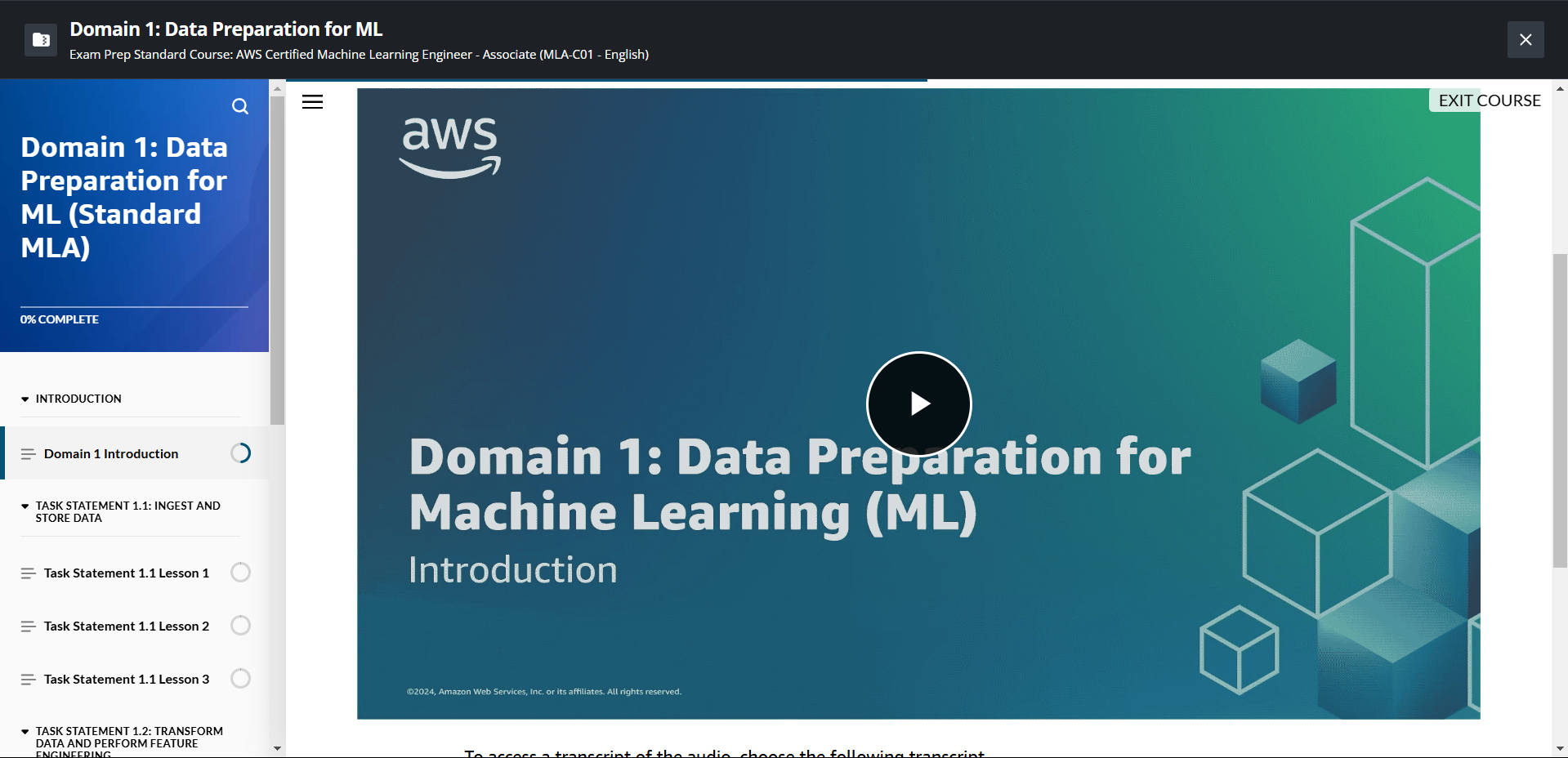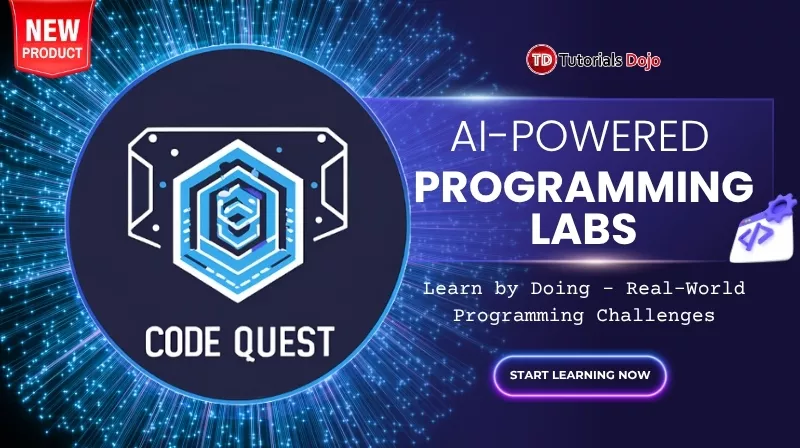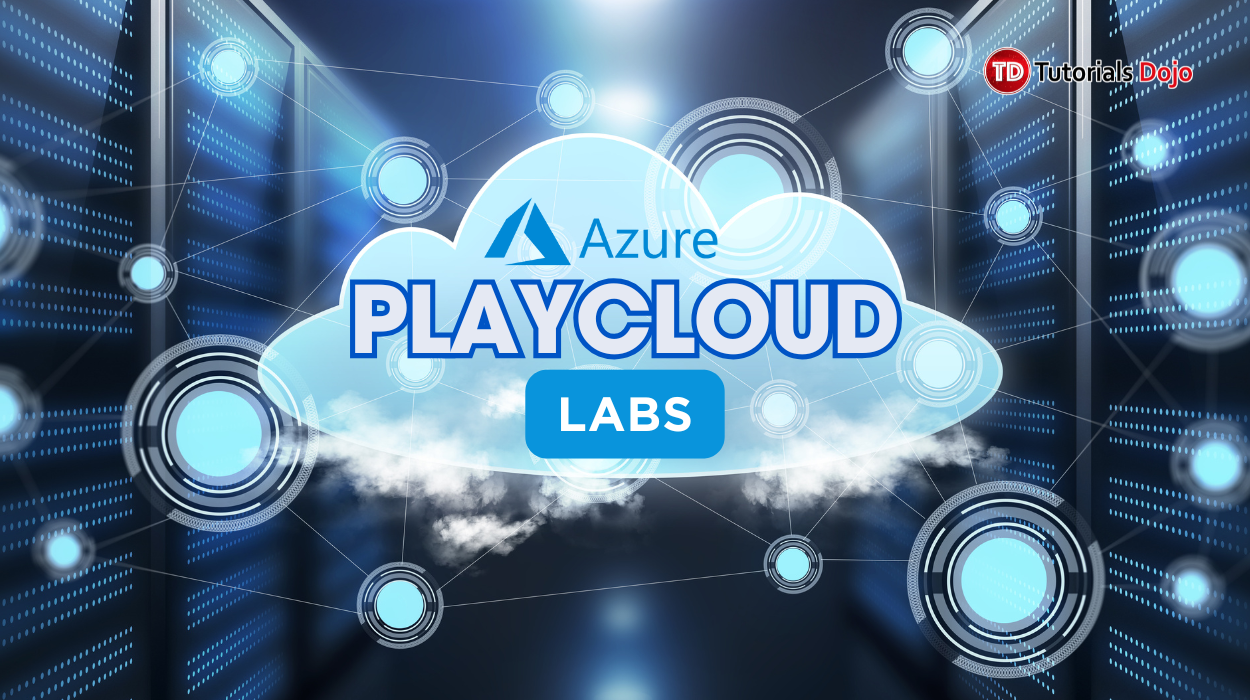The ideal candidate should have a minimum of one year of experience working with Amazon SageMaker and other AWS services for machine learning. They should also have at least one year of experience in a relevant role, such as backend software developer, DevOps developer, data engineer, or data scientist. Aside from that, it is recommended that you already possess general knowledge on these concepts enumerated below:
General IT Knowledge
-
Basic knowledge of popular machine learning algorithms and when to use them
-
Understanding of data engineering, including common data formats, how to bring in data, and how to transform it for ML pipelines.
-
Familiarity with querying and manipulating data.
-
Awareness of software development best practices for writing modular, reusable code, and handling deployment and debugging.
-
Experience with setting up and monitoring ML resources both in the cloud and on-premises.
-
Familiarity with CI/CD pipelines, including its management, and infrastructure as code (IaC)
General AWS Knowledge
-
Familiarity with SageMaker’s tools and algorithms for building and deploying models.
-
Knowledge of AWS services for data storage, processing, and preparation for modeling.
-
Experience with deploying applications and infrastructure on AWS.
-
Understanding of AWS monitoring tools for logging and troubleshooting ML systems.
-
Awareness of AWS security best practices for managing access, encryption, and data protection.
NEW Question types for the AWS Certification Exams!
Last July, the AWS announced that their Certification exams are adding three new question types which are: ordering, matching, and case study. These new question types were included to reduce your reading time while covering more key concepts. Ordering and matching questions are a more efficient method for assessing procedural understanding and pairing skills compared to multiple-choice or multiple-response questions. Meanwhile, case studies allow multiple questions to be asked based on one scenario, so you won’t need to read a new scenario for every question. These new question types will carry the same point value as multiple-choice and multiple-response questions, and they will be integrated throughout the exam alongside the existing question formats. And these new question types will first be featured on this new AWS Certified Machine Learning Engineer-Associate exam (along with the AWS Certified AI Practitioner Exam). That’s why candidates should now adjust their preparation strategies by familiarizing yourself with these new question formats, emphasizing on learning the sequences or processes related to AWS services, and improving more your critical thinking and analysis. This will validate how you can apply your knowledge to develop effective solutions to real-life scenarios and problems.
Even with the addition of new question types, there’s no need to worry as it won’t lead to considerable changes in the exams since the total number of exam questions and allotted time for taking the exam still stays the same with the other Associate exams. The MLA-C01 exam includes 65 questions and your exam results are presented as a scaled score ranging from 100 to 1,000, with a minimum passing score set at 720.
AWS Certified Machine Learning Engineer Associate MLA-C01 Exam Domains
The official exam guide for the AWS Certified Machine Learning Engineer Associate MLA-C01 provides a comprehensive list of exam domains, relevant topics, and services that require your focus. The certification exam comprises of four (4) exam domains and their respective weightings, as shown below:
| MLA-C01 Exam Domains: |
Percentage of Exam (%) |
| Domain 1: Data Preparation for Machine Learning (ML) |
28% |
| Domain 2: ML Model Development |
26% |
| Domain 3: Deployment and Orchestration of ML Workflows |
22% |
| Domain 4: ML Solution Monitoring, Maintenance, and Security |
24% |
| Total: |
100% |
Since the first domain which is “Data Preparation for Machine Learning (ML)” holds the highest exam coverage of 28%, you should give importance to the topics included in this section. However, it’s equally important to devote sufficient attention to the other domains, as they also contribute significantly to your overall understanding and performance on the exam. Each domain plays a crucial role in your preparation, and neglecting them could leave gaps in your knowledge. Listed below are the exam domains and their respective skills and knowledge that you should posses.
MLA-C01 Domain 1: Data Preparation for Machine Learning (ML)
-
1.1: Ingest and Store Data
Data cleaning and transformation techniques help improve datasets by detecting outliers, filling in missing values, combining data, and removing duplicates. Feature engineering enhances analysis through scaling, splitting, binning, and transforming data. Encoding methods like one-hot and label encoding convert categorical data into usable formats. Tools such as SageMaker Data Wrangler and AWS Glue assist in data exploration and transformation, while AWS Lambda and Spark manage real-time streaming data. Finally, data annotation services create labeled datasets for machine learning.
- 1.2: Transform data and perform feature engineering.
Understanding data processing involves knowing how to clean and transform datasets by spotting outliers, filling in missing values, and eliminating duplicates. It also requires mastering feature engineering techniques like scaling, splitting, and normalizing data, as well as encoding methods such as one-hot and label encoding to make data more usable. Familiarity with tools like SageMaker Data Wrangler and AWS Glue helps in exploring and transforming data effectively, while services like AWS Lambda and Spark are key for managing streaming data. Additionally, having skills in AWS tools for transforming data, managing features, and validating datasets, such as using SageMaker Feature Store and SageMaker Ground Truth, is important for creating high-quality labeled datasets.
-
1.3: Ensure data integrity and prepare data for modeling.
Knowledge in data processing includes understanding bias metrics for numeric, text, and image data, such as class imbalance and label differences. It also involves strategies to fix these biases using methods like synthetic data generation and resampling, as well as techniques for encrypting, classifying, anonymizing, and masking data. Being aware of compliance requirements related to personally identifiable information (PII), protected health information (PHI), and data residency is essential. Skills in this area involve validating data quality with tools like AWS Glue DataBrew, identifying and addressing biases with AWS tools like SageMaker Clarify, and preparing data to reduce prediction bias through techniques like splitting, shuffling, and augmentation, along with configuring data for model training using Amazon EFS and Amazon FSx.
MLA-C01 Domain 2: ML Model Deployment
-
2.1: Choose a modeling approach
Knowledge of machine learning (ML) includes understanding how different algorithms can address business challenges and using AWS AI services like Amazon Translate, Amazon Transcribe, Amazon Rekognition, and Amazon Bedrock for specific solutions. It also involves considering model interpretability during selection. Key skills in this area include assessing data and problem complexity to evaluate ML feasibility, choosing suitable models or algorithms, and selecting built-in algorithms and templates from SageMaker JumpStart and Amazon Bedrock. Additionally, it involves considering costs and identifying AI services that fulfill common business needs.
- 2.2: Train and refine models
Knowledge of model training encompasses key components like epochs, steps, and batch size, as well as strategies to reduce training time through early stopping and distributed training. This involves recognizing factors influencing model size and enhancing performance with regularization techniques such as dropout and weight decay. Familiarity with hyperparameter tuning methods, such as random search and Bayesian optimization, is essential, along with understanding the impact of hyperparameters on performance and how to integrate externally built models into SageMaker. Skills in this area include using SageMaker’s built-in algorithms and common ML libraries for development, employing SageMaker script mode with frameworks like TensorFlow and PyTorch, and fine-tuning pre-trained models using Amazon Bedrock or SageMaker JumpStart. Additionally, expertise in hyperparameter tuning with SageMaker’s automatic model tuning (AMT), preventing overfitting and underfitting, combining models through ensembling and boosting, reducing model size via pruning and compression, and managing model versions is important.
-
2.3: Analyze model performance
Knowledge of model evaluation involves understanding various techniques and metrics, including confusion matrices, heat maps, F1 score, accuracy, precision, recall, Root Mean Square Error (RMSE), receiver operating characteristic (ROC), and Area Under the ROC Curve (AUC). It also encompasses methods for creating performance baselines, identifying overfitting and underfitting, and utilizing metrics in SageMaker Clarify to gain insights into machine learning training data and models, as well as recognizing convergence issues. Skills in this area include selecting and interpreting evaluation metrics, detecting model bias, and weighing trade-offs between model performance, training time, and cost. Additionally, it involves conducting reproducible experiments with AWS services, comparing the performance of a shadow variant to a production variant, interpreting model outputs using SageMaker Clarify, and debugging convergence issues with SageMaker Model Debugger.
MLA-C01 Domain 3: Deployment and Orchestration of ML Workflows
-
3.1: Select deployment infrastructure based on existing architecture and requirements
Knowledge of deployment best practices includes understanding concepts like versioning and rollback strategies while utilizing AWS services such as SageMaker. This encompasses serving machine learning models in real time and in batches, provisioning compute resources for production and testing environments, and recognizing the requirements for various deployment types like serverless and batch inference. Additionally, it involves selecting suitable containers and optimizing models for edge devices with tools like SageMaker Neo. Skills in this area focus on evaluating trade-offs in performance, cost, and latency, choosing the right compute environment, and selecting deployment orchestrators like Apache Airflow or SageMaker Pipelines. It also includes deciding between multi-model or multi-container deployments, identifying deployment targets such as SageMaker endpoints or Kubernetes, and determining effective strategies for real-time or batch processing.
- 3.2: Create and script infrastructure based on existing architecture and requirements
Understanding scaling resources involves knowing the difference between on-demand and provisioned resources, comparing scaling policies, and recognizing the benefits of infrastructure as code (IaC) tools like AWS CloudFormation and AWS CDK. It also includes grasping containerization concepts and using AWS container services, alongside implementing SageMaker endpoint auto-scaling to address scalability needs. Key skills focus on applying best practices for building maintainable and cost-effective machine learning solutions, such as enabling automatic scaling, adding Spot Instances with Amazon EC2 and Lambda, and automating resource provisioning. Additionally, proficiency in creating and managing containers through services like Amazon ECR, Amazon EKS, and Amazon ECS is essential, along with configuring SageMaker endpoints in a VPC and deploying models using the SageMaker SDK. Finally, selecting appropriate metrics for auto-scaling, like model latency and CPU usage, is crucial for effective resource management.
-
3.3: Use automated orchestration tools to set up continuous integration and continuous delivery (CI/CD) pipelines
Knowledge of AWS services involves understanding AWS CodePipeline, CodeBuild, and CodeDeploy, along with automating data ingestion using orchestration tools. Familiarity with version control systems like Git and CI/CD principles is key, especially for machine learning workflows. It’s important to know deployment strategies such as blue/green, canary, and linear deployments, as well as how code repositories and pipelines work together. Skills in this area include setting up and troubleshooting these AWS services, using frameworks like Gitflow and GitHub Flow to trigger pipelines, and automating the deployment and building of machine learning models. Additionally, configuring training and inference jobs with tools like Amazon EventBridge and SageMaker Pipelines is crucial, along with creating automated tests for CI/CD pipelines. Finally, developing methods for retraining models helps maintain effective machine learning solutions.
MLA-C01 Domain 4: ML Solution Monitoring, Maintenance, and Security
-
4.1: Monitor model inference
Knowledge in this field covers understanding drift in machine learning models, methods for monitoring data quality and model performance, and best practices for designing monitoring systems. Important skills include using SageMaker Model Monitor to track models in production, identifying anomalies or errors in data processing or model predictions, and detecting changes in data distribution that might affect model performance with tools like SageMaker Clarify. Additionally, being able to assess model performance through A/B testing is crucial for maintaining the effectiveness of machine learning applications.
- 4.2: Monitor and optimize infrastructure and costs
This knowledge area focuses on understanding important performance metrics for machine learning infrastructure, such as utilization, speed, reliability, scalability, and fault tolerance. It involves using tools like AWS X-Ray and Amazon CloudWatch to identify and fix issues with performance and latency, as well as utilizing AWS CloudTrail to track activities related to retraining models. Familiarity with how different types of computing instances can impact performance and knowledge of cost analysis tools, including resource tagging for expense tracking, are also essential. Key skills include setting up and using tools for troubleshooting and analysis, creating CloudTrail logs, and building dashboards to monitor performance metrics with Amazon QuickSight and CloudWatch. Additionally, monitoring infrastructure with EventBridge events, adjusting instance sizes using SageMaker Inference Recommender, and addressing speed and scaling issues are vital. Preparing for cost monitoring by implementing a tagging strategy and resolving capacity challenges related to costs and performance are important tasks. Finally, optimizing expenses with tools like AWS Cost Explorer, AWS Trusted Advisor, and AWS Budgets, along with selecting appropriate purchasing options like Spot Instances, is crucial for effective cost management.
-
4.3: Secure AWS Resources
This knowledge area focuses on understanding IAM roles, policies, and groups that control access to AWS services, including AWS Identity and Access Management (IAM), bucket policies, and SageMaker Role Manager. It also covers security and compliance features of SageMaker, network access controls for machine learning (ML) resources, and best practices for securing CI/CD pipelines. Key skills include setting up least privilege access to ML artifacts, configuring IAM policies and roles, and monitoring and auditing ML systems for security compliance. Additionally, it involves troubleshooting security issues and building Virtual Private Clouds (VPCs), subnets, and security groups to keep ML systems secure.
What AWS services are included in the MLA-C01 Exam?
The AWS Certified Machine Learning Engineer Associate – MLA-C01 Exam Guide provides a breakdown of the exam domains and a comprehensive list of important tools, technologies, and concepts covered in the exam. Below is a non-exhaustive list of AWS services and features that should be studied for the exam based on the information provided in the official exam guide and their corresponding cheat sheets that can serve as your reference guides, providing you information that you need to know about these services. It’s important to remember that this list is subject to change, but it can still be useful in identifying the AWS services that require more attention.
In-scope AWS services and features
|
Analytics:
Application Integration:
Cloud Financial Management:
Compute:
Containers:
Database:
Developer Tools:
|
Machine Learning:
Management and Governance:
Media:
Migration and Transfer:
Networking and Content Delivery:
Security, Identity, and Compliance:
Storage:
|
Exam Prep Materials for the MLA-C01 Exam
You are in luck, as there are a lot of free resources that you can use to prepare for this exam. Interested IT professionals can enroll in various free and premium digital courses to fill gaps in their knowledge and skills. Our team has compiled a list of recommended courses that you can check out which we will update regularly.
Free AWS ML Digital Courses
























